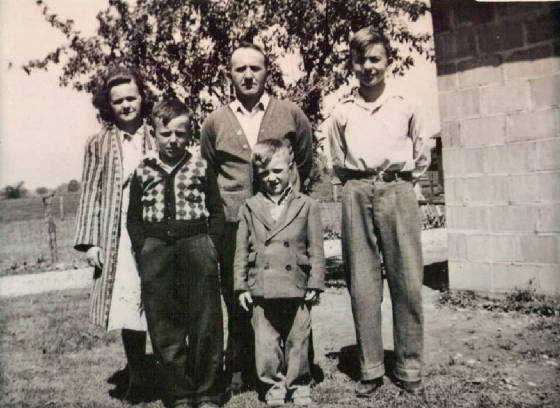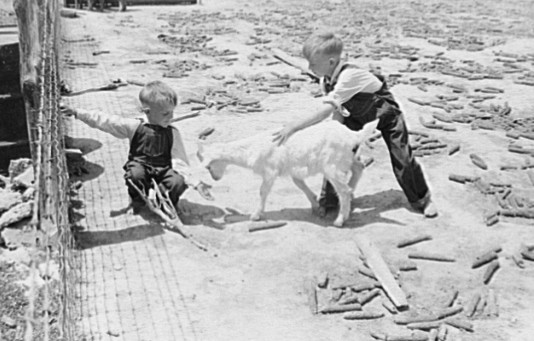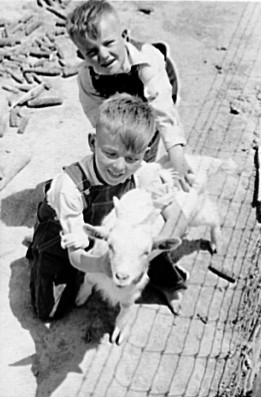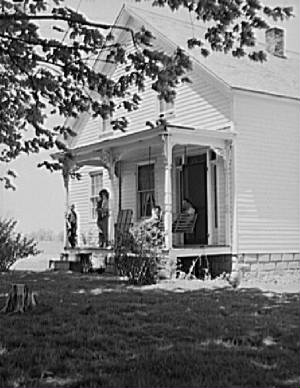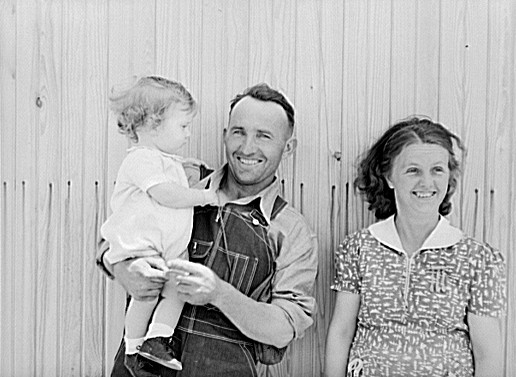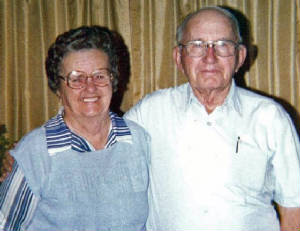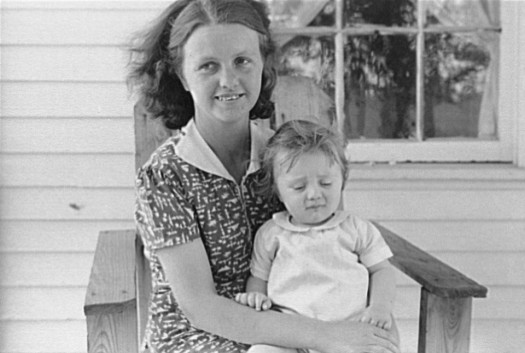
John Vachon caption: Wife and child of FSA (Farm Security Administration) tenant purchase borrower, Crawford County, Illinois, May 1940.
According to the Library of Congress: “The photographs in the Farm Security Administration…form an extensive pictorial record of American life between 1935 and 1944. This U.S. government photography project was headed, for most of its existence, by Roy E. Stryker, who guided the effort in a succession of government agencies: the Resettlement Administration (1935-1937), the Farm Security Administration (1937-1942), and the Office of War Information (1942-1944).”
The FSA was another of the New Deal programs of the Franklin Roosevelt administration. One of its missions was to provide loans to farmers to either acquire land suitable for farming, or to improve their existing farms with the purchase of animals or equipment, or the building of a new house or barn.
John Vachon, one of the celebrated young photographers for the FSA, headed into Illinois in May of 1940, having just roamed farming communities in Iowa and Missouri. He stopped in the Crawford county town of Robinson, in the southern part of the state, where a young family was about to receive an FSA loan. There are about 10 photos of this family on the Library of Congress website, but none of the captions give their names, a typical omission for FSA photos.
I saw the photo above, and was immediately attracted to this lovely, almost Madonna-like portrait, so I contacted the Crawford County Daily News, which subsequently published the photo and a small story about my project. Meanwhile, I found the other photos of the family, and also learned about A Southern Illinois Album, by Herbert K. Russell, a book of FSA photos. I ordered it, and the very day that the UPS driver dropped it off, I received the following email:
“I am writing to you about a picture that was in my local paper today of a woman and a child. That is Minnie and Donald Patton, my mother and baby brother. My name is Charles Patton, and I am 77 years old.”

John Vachon caption: FSA (Farm Security Administration) tenant purchase borrower, Crawford County, Illinois, May 1940.
Paul E. Patton was born March 5, 1906, in Illinois. He married Minnie May Roy in about 1927. She was born in Missouri on September 29, 1910. When they married, Paul was 22 and Minnie was 16. In April of 1930, according to the census, they lived in Robinson with Paul’s parents, Thomas and Stella, both natives of Indiana. Their first son, Charles, would be born later that year. I interviewed Charles. See the text of that interview below.
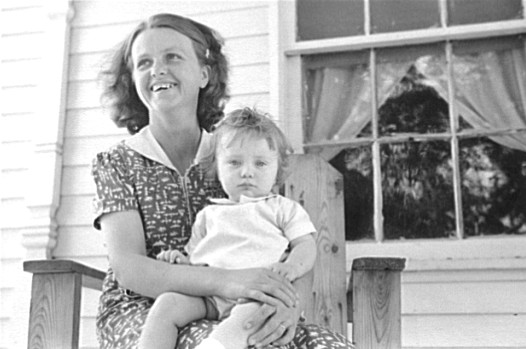
*Photos provided by the Patton family, except where noted.
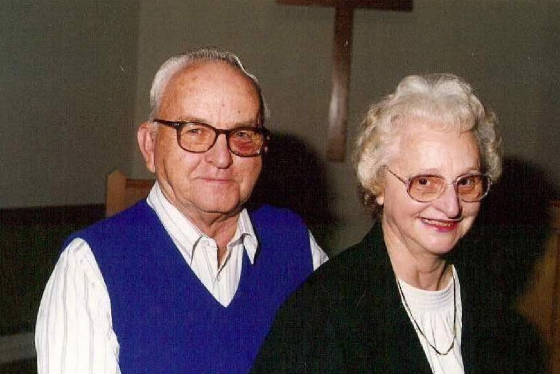
Edited interview with Charles Patton CP), son of Paul and Minnie Patton, conducted by Joe Manning (JM), on February 11, 2008.
JM: How did you know about the pictures?
CP: Southern Illinois University put out a book in 1990. It had photos of the Depression era in it. My sister-in-law happened to be in the library, and saw the book lying on the counter. On the cover was a picture of my dad and mother and two of the boys. So she checked out the book and showed it to me, and then I found out about three years later that that were a few pictures of my family in the Library of Congress. I’m the older boy in that picture on the cover, the one on the right.
JM: Did your parents see the photos?
CP: My father saw the ones in the book. But he never saw all the ones on the Library of Congress website. He died before we knew about that. He would have gotten a kick out of it.
JM: Did he remember the pictures being taken?
CP: Yea, he did.
JM: Do you remember the photos being taken?
CP: I’m not sure. I remember the photographer being there when me and my brother were playing with the goat, but I don’t remember whether I realized he was taking a picture.
JM: How many goats did you have?
CP: None really, except for that pet goat. I don’t remember where we got him or what happened to him. When the guys down at the coffee shop saw the picture that was in the newspaper recently, they were kidding me. One of them said, ‘They should have put the names in there so we’d know which one was the goat.’
JM: There’s a radio in one of the pictures.
CP: I remember that. It was battery-operated, a dry cell. I listened to it when they’d let me. They wouldn’t let me listen very much because you’d run the battery down. When I came home from school, I always wanted to listen to The Lone Ranger. If they were outside, I’d turn it on and listen anyway. We didn’t get electricity till a little after the pictures were taken, sometime in the summer of 1940. When we got it, I could hardly wait for it to get dark, so I could turn on the light.
JM: Who are the kids in the photo sitting on top of the radio?
CP: That’s me and Carl.
JM: Did the FSA help your parents?
CP: Oh, yes. My dad was able to buy 135 acres and a house and barn, and I think he had 40 years to pay for it, and the interest rate was real cheap. He had been living about three miles from there in an old house that he rented. His father, who was a blacksmith, lived just down the road, also in a rented house. My dad was farming the ground, and I think he was doing some other work, too. He lived near the river and had a team of horses. He mowed the levee in the summer. There were 10 families in Crawford County that bought farms with FSA loans.
JM: Do you think that your parents could have had what they had without that government program?
CP: I don’t see how they could’ve. Of the 10 people that borrowed money, only one of them didn’t make it. The other nine did alright.
JM: What did your parents grow on the farm?
CP: Corn, soy beans and wheat.
JM: Did you parents have any hired hands?
CP: No.
JM: What did your mother do on the farm?
CP: She drove a tractor out in the field. She took care of the chickens, did some milking, and did lots of canning. We had to heat water outside in a big old kettle so she could wash. We had to carry the water from the well to the heater, then carry it to the washing machine sitting on the back porch. That was another job I had when I was a kid. The washing machine was one of those Maytags with a gasoline motor, before we got electricity.
JM: Did you have indoor plumbing?
CP: We didn’t have it till Dad tore down the house and built a new one there in 1949. Before that, we had an outside toilet. The WPA sent a crew around to build that. They were well built. The schoolhouses around here had them. When I went to country school, they had one. I used to walk to school, about a half-mile from my house. When Dad could finally afford to buy a bicycle, I rode that to school.
JM: What did you do when it snowed?
CP: You put on four or five-buckle overshoes and walked. We’d carry rocks in our pockets, and when we saw a rabbit in the snowbank, we’d try to hit him.
JM: Did you ever get one of them?
CP: Yes sir, I did. I’d dragged him home, and it made good eating. I still like them today.
JM: Who played the organ?
CP: My mom. She didn’t play that much. I don’t know where it came from, maybe from her folks. My dad threw it away when he built the new house. That was too bad, because I think it would be worth something today. He also threw away the radio and an old Victrola in a big cabinet. It played those cylinders.
JM: What did you do for recreation?
CP: We worked all the time. Dad eventually got about 18 milk cows, and we had to help him milk every morning and every evening. When I was in high school, I had to milk before I went, and then I had to hurry home to do it again. Me and my brothers and my mom had to do that seven days a week. I never went to a football game or anything when I was in high school.
JM: What were your parents like?
CP: My dad and mother were both very religious. They belonged to the Church of Christ. They went every Sunday, ever since I can remember.
JM: How many children did they have?
CP: Five altogether. I was born in 1930. Then it was Carl, and then Donald. I had an older sister who died when she was two weeks old, and I had a younger brother who was stillborn.
JM: What did your two brothers do when they grew up?
CP: They both worked in factories. One of them worked in a shoe factory here, and the other worked in a lot of different jobs.
JM: Did they both get married?
CP: Yes. Carl had two children, and Donald had four. Carl died in 1989, and Donald died in 1998.
JM: Did you continue to be a farmer?
CP: I lived on the farm till I got married, in 1950. I’ll be married 58 years this week. I got me a job in town, but I still helped my dad. I rented 80 acres, bought me a tractor and everything, and I started farming it. I helped my dad and he helped me. I just kept farming more and more, and then finally I quit my job. When my dad quit farming, I rented his farm, and then I bought it in 1978. I don’t live there now; I live on some more ground I own. When I bought my dad’s farm, he kept the house and two acres. When he died, I didn’t want the house, so I sold it and the two acres, but I still own several acres close to it. I’m retired now, but I own 730 acres, and I rent the farm out.
JM: When you got your own farm, were you always working, too?
CP: Yes, I was.
JM: Did your kids help you as much as you helped your father?
CP: Well, I had two girls. We had some farmhands then, so I made my daughters feed the chickens and gather the eggs. They never worked like I had to work.
JM: Did you ever get the urge to leave Southern Illinois and go somewhere else, or do something else rather than farming?
CP: No. I liked it and stuck with it till I got old enough to retire. I grew corn and soybeans and wheat. At one time, I was feeding cattle, too. I had a few hired hands. I was farming about 5,000 acres when I quit. I had some tough times, but I still miss it.
Minnie Patton passed away on August 22, 1989, at the age of 78; Paul Patton passed away on September 11, 1999, at the age of 93.
*Story published in 2008.
